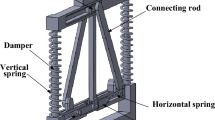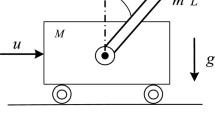Abstract
In modern medical techniques, the medical bubbles are widely employed for ultrasonic imaging, targeted drug delivery, and cancer treatment. However, the nonlinear oscillations of medical bubbles restrict the applications of bubble technology in medicine. To prevent bubble oscillations, this problem is solved through control engineering point of view. For this purpose, the nonlinear dynamics of two interacting bubbles in the incompressible liquid is presented. In continuation, the fractional-order sliding mode controller is proposed to regulate the radius of bubbles. In this closed-loop system, the ultrasonic waves play the role of control input signals and the outputs are the radius of bubbles which are measured by the image processing. The stability of the closed-loop system is ensured by the Lyapunov theorems. The switching gains are scheduled adaptively according to the fuzzy logic system. The simulation results including the cases of parametric uncertainty, measurement noise, and analysis of the steady state error are presented to demonstrate the efficiency of the proposed method. The results of this research are of immediate interest for modern medical applications.










Similar content being viewed by others
Data Availability
Data will be available to the readers upon a formal request from the corresponding author.
References
Lohse D (2018) Bubble puzzles: from fundamentals to applications. Phys Review Fluids 3(11):110504
Dollet B, Marmottant P, Garbin V (2019) Bubble dynamics in soft and biological matter. Annu Rev Fluid Mech 51:331–355
Simon JC et al (2018) The role of trapped bubbles in kidney stone detection with the color Doppler ultrasound twinkling artifact. Phys Med Biol 63(2):025011
Izadifar Z, Babyn P, Chapman D (2019) Ultrasound cavitation/microbubble detection and medical applications. J Med Biol Eng 39(3):259–276
Wischhusen J, Frédéric P (2019) Ultrasound-targeted microbubble destruction (UTMD) for localized drug delivery into tumor tissue. Irbm 40(1):10–15
Zandi A et al (2019) Microneedle-based generation of microbubbles in cancer tumors to improve ultrasound-assisted drug delivery. Adv Healthcare Mater 8(17):1900613
Garbin V (2019) Collapse mechanisms and extreme deformation of particle-laden interfaces. Curr Opin Colloid Interface Sci 39:202–211
Zhang J, Zhang L, Deng J (2019) Numerical study of the collapse of multiple bubbles and the energy conversion during bubble collapse. Water 11(2):247
Shen W et al (2016) Effect of cavitation bubble collapse on hydraulic oil temperature. J Centr South Univ 23(7):1657–1668
Davis JA, Stewart M (2002) Predicting globe control valve performance—Part I: CFD modeling. J Fluids Eng 124(3):772–777
Yaghoubi H, Madani SAH, Alizadeh M (2018) Numerical study on cavitation in a globe control valve with different numbers of anti-cavitation trims. J Centr South Univ 25(11):2677–2687
Doinikov AA et al (2019) Nonlinear dynamics of two coupled bubbles oscillating inside a liquid-filled cavity surrounded by an elastic medium. Phys Rev E 99(5):053106
Hegedűs F, Kalmár C (2018) Dynamic stabilization of an asymmetric nonlinear bubble oscillator. Nonlinear Dyn 94(1):307–324
Heckman C, Rand R (2013) Dynamics of microbubble oscillators with delay coupling. Nonlinear Dyn 71(1–2):121–132
Haghi H, Sojahrood A, Kolios MC (2019) Collective nonlinear behavior of interacting polydisperse microbubble clusters. Ultrason Sonochem 58:104708
Garashchuk IR, Sinelshchikov DI, Kudryashov NA (2018) Nonlinear dynamics of a bubble contrast agent oscillating near an elastic wall. Regul Chaotic Dyn 23(3):257–272
Qi W, Zong G, Karimi HR (2019) Sliding mode control for nonlinear stochastic semi-Markov switching systems with application to space robot manipulator model. IEEE Trans Ind Electron 67(5):3955–3966
Zhu Y, Qiao J, Guo L (2018) Adaptive sliding mode disturbance observer-based composite control with prescribed performance of space manipulators for target capturing. IEEE Trans Industr Electron 66(3):1973–1983
Badfar E, Abdollahi R (2020) Design of an adaptive nonsingular terminal sliding mode using supervisory fuzzy for the output voltage control of a buck converter. J Appl Res Technol 18(2):77–88
Badfar E, Zaferani EJ, Nikoofard A (2022) Design a robust sliding mode controller based on the state and parameter estimation for the nonlinear epidemiological model of Covid-19. Nonlinear Dyn 109(1):5–18
Yin Y et al (2018) Observer-based adaptive sliding mode control of NPC converters: an RBF neural network approach. IEEE Trans Power Electron 34(4):3831–3841
Fei J, Lu C (2018) Adaptive fractional order sliding mode controller with neural estimator. J Franklin Inst 355(5):2369–2391
Laware A, Talange D, Bandal V (2018) Evolutionary optimization of sliding mode controller for level control system. ISA Trans 83:199–213
Cao Y et al (2019) Bio-inspired speed curve optimization and sliding mode tracking control for subway trains. IEEE Trans Veh Technol 68(7):6331–6342
Yu J et al (2017) Depth control of a bioinspired robotic dolphin based on sliding-mode fuzzy control method. IEEE Trans Industr Electron 65(3):2429–2438
Yu Y et al (2017) Fuzzy adaptive back-stepping sliding mode controller for high-precision deflection control of the magnetically suspended momentum wheel. IEEE Trans Industr Electron 65(4):3530–3538
Ostad-Ahmad-Ghorabi MJ, Zahery MM, and Abbasy S (2012) Suppression of chatter vibration by fuzzy sliding mode control in machining processes. In: Advanced materials research. Trans Tech Publications, Switzerland
Tsirimokou G et al (2017) Electronically tunable fully integrated fractional-order resonator. IEEE Trans Circuits Syst II Express Briefs 65(2):166–170
Wang J et al (2019) Fractional order equivalent circuit model and SOC estimation of supercapacitors for use in HESS. IEEE Access 7:52565–52572
Ullah N et al (2017) Improving the hardware complexity by exploiting the reduced dynamics-based fractional order systems. IEEE Access 5:7714–7723
Chen K et al (2018) Robust adaptive fractional-order observer for a class of fractional-order nonlinear systems with unknown parameters. Nonlinear Dyn 94(1):415–427
Gong Y et al (2019) Observer-based time-varying formation control of fractional-order multi-agent systems with general linear dynamics. Express Briefs, IEEE Trans Circuits Syst II
Sun G, Ma Z, Yu J (2017) Discrete-time fractional order terminal sliding mode tracking control for linear motor. IEEE Trans Industr Electron 65(4):3386–3394
Zou Z-X et al (2014) Frequency-adaptive fractional-order repetitive control of shunt active power filters. IEEE Trans Industr Electron 62(3):1659–1668
Dumlu A, Erenturk K (2013) Trajectory tracking control for a 3-dof parallel manipulator using fractional-order PIλDμ control. IEEE Trans Industr Electron 61(7):3417–3426
Zaihidee FM, Mekhilef S, Mubin M (2019) Application of fractional order sliding mode control for speed control of permanent magnet synchronous motor. IEEE Access 7:101765–101774
Xu S et al (2018) Fractional-order fuzzy sliding mode control for the deployment of tethered satellite system under input saturation. IEEE Trans Aerosp Electron Syst 55(2):747–756
Carroll JM, Lauderbaugh LK, Calvisi ML (2013) Application of nonlinear sliding mode control to ultrasound contrast agent microbubbles. J Acoust Soc Am 134(1):216–222
Najafi M, Azadegan M, and Beheshti MT (2016) Stability analysis and sliding mode control of a single spherical bubble dynamics. In: 2016 American control conference (ACC). IEEE
Badfar E, Ardestani MA (2019) Utilizing sliding mode control for the cavitation phenomenon and using the obtaining result in modern medicine. SN Appl Sci 1(11):1419
Badfar E, Ardestani MA (2019) Robust versus optimal control for the radius of spherical bubble in a perfect incompressible liquid, LMI optimization approach. Int J Dyn Control 8(2):497–507
Rahmatizadeh B et al (2021) Stability analysis and sliding mode control of a single spherical bubble described by Keller-Miksis equation. Int J Dyn Control 9(4):1757–1764
Badfar E, Ardestani MA, Beheshti MT (2020) Robust nonsingular terminal sliding mode control of radius for a bubble between two elastic walls. J Control, Autom Electr Syst 31(2):283–293
Badfar E, Ardestani MA (2019) Robust versus optimal control for the radius of spherical bubble in a perfect incompressible liquid, LMI optimization approach. Int J Dyn Control 8(2):497–507
Badfar E, Ardestani MA (2020) Design of adaptive fuzzy gain scheduling fast terminal sliding mode to control the radius of bubble in the blood vessel with application in cardiology. Int J Dyn Control 9(1):199–210
Liang J et al (2017) Dynamics of two interacting bubbles in a nonspherical ultrasound field. Ultrasonics 75:58–62
Garashchuk IR et al (2019) Hyperchaos and multistability in the model of two interacting microbubble contrast agents. Chaos An Interdiscip J Nonlinear Sci 29(6):063131
Zhang Y, Finch J (2001) A note on single bubble motion in surfactant solutions. J Fluid Mech 429:63–66
Doinikov AA, Manasseh R, Ooi A (2005) Time delays in coupled multibubble systems (L). J Acoust Soc Am 117(1):47–50
Supponen O, D Obreschkow and M Farhat (2019) High-speed imaging of high pressures produced by cavitation bubbles. In: 32nd international congress on high-speed imaging and photonics. International society for optics and photonics
Kauer M et al (2018) High-speed imaging of ultrasound driven cavitation bubbles in blind and through holes. Ultrason Sonochem 48:39–50
Li, C. and F. Zeng, Numerical methods for fractional calculus. 2015: Chapman and Hall/CRC.
Azar, A.T., S. Vaidyanathan, and A. Ouannas, Fractional order control and synchronization of chaotic systems. Vol. 688. 2017: Springer
Efe MÖ (2010) Fractional order sliding mode controller design for fractional order dynamic systems. new trends in nanotechnology and fractional calculus applications. Springer, pp 463–470
Mohammadzaheri M, Chen L (2010) Intelligent predictive control of a model helicopter’s yaw angle. Asian J Control 12(6):667–679
Kang C et al (2018) Effects of initial bubble size on geometric and motion characteristics of bubble released in water. J Central South Univ 25(12):3021–3032
Funding
There is no funding source available for this research.
Author information
Authors and Affiliations
Contributions
EB contributed to writing, simulation, mathematical formulation; MA contributed to supervision, writing, simulation; MN contributed to supervision, mathematical formulation.
Corresponding author
Ethics declarations
Conflict of interest
The authors declare that there is no conflict of interest.
Code Availability
Code will be available to the readers upon a formal request from the corresponding author.
Rights and permissions
Springer Nature or its licensor (e.g. a society or other partner) holds exclusive rights to this article under a publishing agreement with the author(s) or other rightsholder(s); author self-archiving of the accepted manuscript version of this article is solely governed by the terms of such publishing agreement and applicable law.
About this article
Cite this article
Badfar, E., Ardestani, M. & Najafi, M. Design of robust fractional-order sliding mode with fuzzy supervisor to control the nonlinear oscillation of two interacting bubbles. Int. J. Dynam. Control 11, 1914–1925 (2023). https://doi.org/10.1007/s40435-022-01096-z
Received:
Revised:
Accepted:
Published:
Issue Date:
DOI: https://doi.org/10.1007/s40435-022-01096-z




